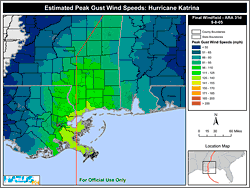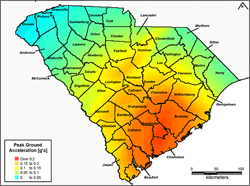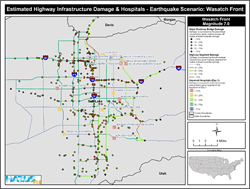HAZUS-MH Inventory: Potential Applications

In order to assess and mitigate the impacts of a natural hazard such as an earthquake, flood or hurricane, it is necessary to have an understanding of the potential size of an event (hazard identification) and the characteristics of the population and environment that will be impacted (inventory collection).
A unique feature of HAZUS-MH is the national inventory that comes with the model. Inventory data includes 1) Essential Facilities: police, fire, emergency operations facilities, schools, medical facilities; 2) Lifelines: utilities and transportation; 3) General Building Stock: residential, commercial, and industrial (aggregated by square footage); and 4) Demographic Data, which can be aggregated by age, income, sex, households and other attributes that have a direct bearing on vulnerability to disasters. The Summary of HAZUS-MH Databases provides a very useful reference for these databases.
HAZUS-MH uses the inventories to estimate losses from earthquakes, hurricanes and floods. The accuracy of loss estimates are greatly improved by accurate and complete inventories. The HAZUS-MH inventory has several potential applications for planners, emergency responders and decision-makers. Several uses are highlighted below.

HAZUS-MH can delineate the boundaries of a hazard and exposure of population and built environment.
The HAZUS-MH hurricane model can estimate wind intensity from specific events, including peak gust wind speeds and maximum sustained winds. The earthquake model shows peak ground acceleration and areas of potential liquefaction. The ability to depict hazard boundaries and hazard intensity (wind speeds, ground shaking) with demographic data provides decision-makers with a good idea of vulnerable populations. View larger map graphic of Estimated Peak Wind Gusts Speeds: Hurricane Katrina.

HAZUS-MH inventory data (population, essential facilities, general building stock, utility and transportation lifelines) can also be used with the earthquake model to show peak ground acceleration (PGA), an indication of the intensity of an earthquake. In the PGA map of South Carolina from a magnitude 7.2 earthquake, the orange areas (over 0.2 PGA) have a high probability of major damage from ground shaking. View larger graphic example of PGA in South Carolina during a 7.2 magnitude earthquake.

HAZUS-MH can show the location of essential facilities and lifelines (utilities and transportation) and estimate the potential for loss of functionality in scenario events.
The ability of a community to respond to a major disaster is determined in large part by the availability (and functionality) of hospitals, emergency services and other essential facilities and lifelines.
In Utah, FEMA and the Utah Division of Homeland Security have used HAZUS-MH to assess the potential damages and loss of functionality to highways, hospitals and other key lifelines in scenario earthquakes. This analysis has several important applications for Utah emergency managers. It can be used to:
- Identify highway bridges and essential facilities – including hospitals – that have a moderate to high probability of failure in different scenario earthquake events.
- Identify potential shortfalls in hospitals services in scenario earthquakes.
- Support pre-disaster planning for emergency response, including mutual aid agreements and ESF #8 (Public Health and Medical Services).
- Support Logistics planning – using the analysis of bridges that are most vulnerable to damaging earthquakes.
HAZUS-MH can show the location of unreinforced masonry structures (URMs), by far the most vulnerable structure in earthquakes.
Post-disaster studies continue to show that URMs do not perform well in earthquakes, and generate a disproportionate number of casualties from failed structures. The HAZUS-MH inventory can be used to show the concentrations of URMs by census tract in moderate to high risk urban areas (e.g., St. Louis, Memphis). This information can be used to identify areas with high probability of casualties; damage and functionality of hospitals in the impacted area; and probability of bridge damage and debris, which will affect accessibility, emergency response and logistics.
Download the handout version of this story.
Last Modified: Wednesday, 20-Aug-2008 14:46:19 EDT
